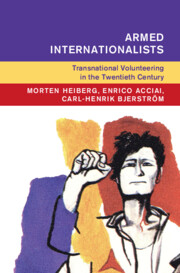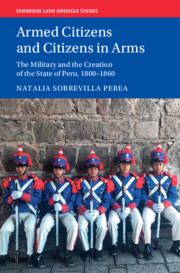Refine search
Actions for selected content:
15366 results in Military history
Copyright page
-
- Book:
- Armed Citizens and Citizens in Arms
- Published online:
- 12 September 2025
- Print publication:
- 25 September 2025, pp iv-iv
-
- Chapter
- Export citation
Epigraph
-
- Book:
- Armed Citizens and Citizens in Arms
- Published online:
- 12 September 2025
- Print publication:
- 25 September 2025, pp vi-vi
-
- Chapter
- Export citation
5 - Montepíos, a Corporate Identity of Colonial Origin
-
- Book:
- Armed Citizens and Citizens in Arms
- Published online:
- 12 September 2025
- Print publication:
- 25 September 2025, pp 186-207
-
- Chapter
- Export citation
Index
-
- Book:
- Armed Citizens and Citizens in Arms
- Published online:
- 12 September 2025
- Print publication:
- 25 September 2025, pp 215-220
-
- Chapter
- Export citation
Dedication
-
- Book:
- Armed Citizens and Citizens in Arms
- Published online:
- 12 September 2025
- Print publication:
- 25 September 2025, pp v-v
-
- Chapter
- Export citation
2 - On Being a Citizen-Soldier
-
- Book:
- Armed Citizens and Citizens in Arms
- Published online:
- 12 September 2025
- Print publication:
- 25 September 2025, pp 55-99
-
- Chapter
- Export citation
1 - Antecedents
-
- Book:
- Armed Citizens and Citizens in Arms
- Published online:
- 12 September 2025
- Print publication:
- 25 September 2025, pp 29-54
-
- Chapter
- Export citation
Conclusions
-
- Book:
- Armed Citizens and Citizens in Arms
- Published online:
- 12 September 2025
- Print publication:
- 25 September 2025, pp 208-214
-
- Chapter
- Export citation
3 - Blood Spilled in Battle
-
- Book:
- Armed Citizens and Citizens in Arms
- Published online:
- 12 September 2025
- Print publication:
- 25 September 2025, pp 100-133
-
- Chapter
- Export citation
Acknowledgments
-
- Book:
- Armed Citizens and Citizens in Arms
- Published online:
- 12 September 2025
- Print publication:
- 25 September 2025, pp viii-xiv
-
- Chapter
- Export citation
4 - Soldiers at War and Peace
-
- Book:
- Armed Citizens and Citizens in Arms
- Published online:
- 12 September 2025
- Print publication:
- 25 September 2025, pp 134-185
-
- Chapter
- Export citation
Introduction
-
- Book:
- Armed Citizens and Citizens in Arms
- Published online:
- 12 September 2025
- Print publication:
- 25 September 2025, pp 1-28
-
- Chapter
- Export citation

Armed Internationalists
- Transnational Volunteering in the Twentieth Century
-
- Published online:
- 19 September 2025
- Print publication:
- 09 October 2025

Armed Citizens and Citizens in Arms
- The Military and the Creation of the State of Peru, 1800‒1860
-
- Published online:
- 12 September 2025
- Print publication:
- 25 September 2025
Copyright page
-
- Book:
- Less Than Victory
- Published online:
- 16 October 2025
- Print publication:
- 11 September 2025, pp iv-iv
-
- Chapter
- Export citation
Acknowledgments
-
- Book:
- Ability and Difference in Early Modern China
- Published online:
- 10 September 2025
- Print publication:
- 11 September 2025, pp ix-ix
-
- Chapter
- Export citation
4 - Educating the Entitled
-
- Book:
- Ability and Difference in Early Modern China
- Published online:
- 10 September 2025
- Print publication:
- 11 September 2025, pp 82-114
-
- Chapter
- Export citation
Index
-
- Book:
- Less Than Victory
- Published online:
- 16 October 2025
- Print publication:
- 11 September 2025, pp 295-306
-
- Chapter
- Export citation
Introduction: “Evidence of Loyalty”
-
- Book:
- Less Than Victory
- Published online:
- 16 October 2025
- Print publication:
- 11 September 2025, pp 1-13
-
- Chapter
- Export citation
9 - Turning Every Page
-
- Book:
- Ability and Difference in Early Modern China
- Published online:
- 10 September 2025
- Print publication:
- 11 September 2025, pp 212-230
-
- Chapter
- Export citation
